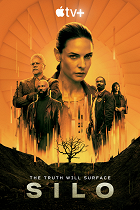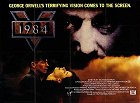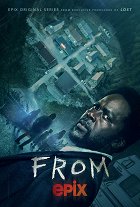Sci-fi - Genres
Hottest on Streaming Today
The Science Fiction genre and its characteristics
Science fiction, or sci-fi, is a fictional genre that works with science, fantastic and futuristic themes, speculative technology, extraterrestrial beings, space exploration and visiting alien or parallel worlds, teleportation and paranormal abilities, time travel, the development of robotics and cybernetics, and the general evolution of humanity in the near or distant future. The basis of science fiction films is the combination of human existence with supernatural elements achieved by working with the real knowledge of science and technology, but relegating it to the level of fiction and theoretical visions (as opposed to the fantasy genre, in which the supernatural elements are the work of magic). In addition, science fiction can also cross over into other genres such as drama, comedy, horror, western and many others. Many science fiction films are based on literary works by famous writers, such as H.G. Wells, Isaac Asimov, Ray Bradbury, Arthur Charles Clarke, Philip K. Dick and Jules Verne.
The science fiction genre is divided into many sub-categories. Most science fiction films are set in various stages of the near or distant future (relative to the time of their creation), and in some cases our present has already caught up with these periods, offering a comparison of reality with the visions of the filmmakers of the time. Early science fiction films in particular show that they were made with limited knowledge of space and alien planets, and can therefore sometimes look a bit naive. Some science fiction films are set in an alternate reality that works with our past or present, but altered in some way and enriched with non-existent elements. They are usually based on the idea of what the world would look like if, at some point in our history, certain events had unfolded differently from historical knowledge. Other films deal with life in utopias or dystopias, or depict human societies in post-apocalyptic worlds that have suffered some kind of ecological or nuclear disaster. In general, science fiction films usually try to draw audiences in with attractive themes and provide them with entertainment, but in some cases they also contain social criticism or philosophical overtones that invite intellectual debate.
The first science fiction films
A Trip to the Moon (1902), which told the story of a group of astronauts who arrive on the moon, have all sorts of adventures and visit a colony of aliens, is considered the first science fiction film in the history of cinema. It is the most famous work of French director and pioneer of film effects Georges Méliès, who made science fiction and fantasy films shortly after the invention of the medium. Two years later, he followed up A Trip to the Moon with The Impossible Voyage (1904), inspired by a Jules Verne's play, which told the story of a group of adventurers making a journey around the world by all available means of transport, eventually landing on the Sun. Another work of Jules Verne, this time the novel “20,000 Leagues Under the Sea”, was the inspiration in 1916 for a film with the same name made by British-born director Stuart Paton.
In the 1920s Europe produced remarkable science fiction films that, in addition to attractive effects and fantastical visions of life in the future, had complex social and critical themes. The first feature-length science fiction film to tell the story of an endearingly naive conquest of space was the Danish A Trip to Mars (1918), while the Italian sci-fi comedy The Mechanical Man (1921), the story of a scientist and the humanoid tinplate robot he has built, whose plans for production fall into the wrong hands, culminated in the first fight between two robots in the history of cinema. In the Soviet science fiction film Aelita: Queen of Mars (1924), a group of communist engineers travel to the red planet, where they plant the seeds of popular revolution in its civilization. The French comedy science fiction film The Crazy Ray (1925) told the story of a mysterious ray that put the whole of Paris to sleep, except for the Eiffel Tower guards and a few passengers from a plane, who were not affected and therefore had free rein in the city.
Metropolis (1927), a German expressionist film by Fritz Lang, was a seminal contribution to the genre. Although it had a rather lukewarm reception when in premiered, it would eventually become a legend that influenced many later filmmakers. It presented audiences with a dystopian future in which society was divided between the rich living in luxury on the surface of the earth and the working poor toiling underground to keep the cities running for those above. This pioneering film stunned with its evocative, monumental images of a futuristic city whose oppressive atmosphere contrasted with the simple love story of a man and a woman from different social classes. Fritz Lang would later contribute again to the genre with Woman in the Moon (1929), about a love triangle and a plan to mine gold on the moon. It was one of the last major films of the silent era, even though it was made already in the sound film era.
Metropolis (1927)
Photo © Universum Film A.G. (UFA)
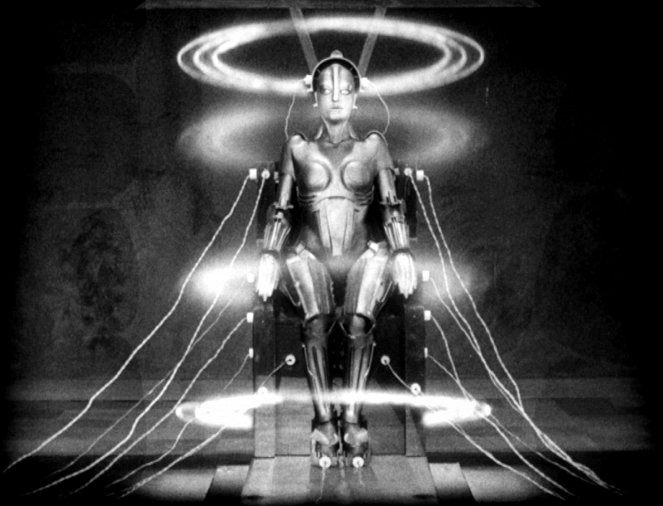
Early sound science fiction films
The most important science fiction films of the 1930s and 40s were made in Hollywood and the UK, and early on in this period many of them were blessed with relatively generous budgets that allowed their creators to splurge on expensive and spectacular sets and special effects. The American musical sci-fi comedy Just Imagine (1930) by David Butler portrayed a world in 1980 in which the protagonist has been put to sleep for 50 years. The British film Things to Come (1936), scripted by H.G. Wells based on his own novel, depicted the future as a time of long wars and dictatorships that would ultimately lead to peace, development and prosperity. By contrast, the German science fiction film The Master of the World (1934) dealt with robots that would become a threat to humanity in the future, first as a replacement for labour and then as war machines. The science fiction genre also included the famous American horror films Frankenstein (1931), Dr. Jekyll and Mr. Hyde (1931) and The Invisible Man (1933), thanks to their themes of scientists whose daring experiments get out of hand (and the same was true of their many later sequels and remakes).
The characters of ambitious scientists were also explored in the sci-fi horror films Black Friday (1940), in which a surgeon transplants part of his dying colleague's brain from the head of a gangster, creating a man with a split personality, Dr. Cyclops (1940), in which the heroes are reduced to miniature size by a mad scientist after finding his mansion in the middle of the jungle, and Man Made Monster (1941), in which a doctor treating the only survivor of an electrocuted train accident inadvertently turns him into an electric killer. In the sports science fiction film It Happens Every Spring (1949), a mediocre chemist becomes an incredibly successful baseball player, thanks to his invention of a special wood-repellent spray. The British film The Perfect Woman (1949) depicts the creation of a seemingly perfect robotic woman (played by a live actress) that ultimately ends in disaster.
The Invisible Man (1933)
Photo © Universal Pictures
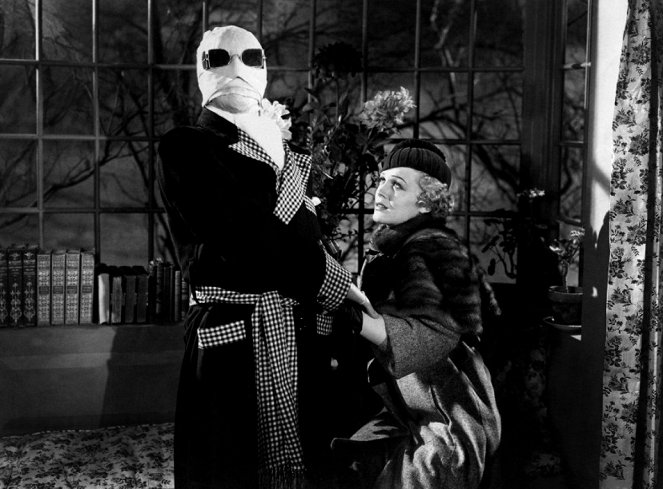
The Golden Age of classic science fiction in the 1950s
In the 1950s, science fiction in American cinema was marked by a fascination with space and the possibilities of exploring it, leading to a number of films themed around this motif, and also the fear of a potential war with the Soviet Union, which was reflected in the form of stories about visits and attacks by aliens. This period, which saw the production of many famous science fiction films and was later referred to as the Golden Age, began with the release of Destination Moon (1950) and Rocketship X-M (1950). The former captured for the first time the rivalry between the US and the Soviet Union over man's flight to the moon, offered groundbreaking effects for its time, and also had scenes set in weightlessness. The latter, on the other hand, looked less believable, not least because of the story of the astronauts, forced to change course during their journey to the moon, fly to Mars, where they find the remains of an ancient civilisation.
Typical representatives of famous classic science fiction from this period were The Day the Earth Stood Still by Robert Wise (1951), in which humanity is visited by a peaceful alien with an important message, but who is nevertheless perceived as an enemy and a threat by the suspicious world powers, Byron Haskin’s The War of the Worlds (1953), based on the novel by H.G. Wells about the invasion of an alien race with advanced technology that could not be matched by Earth's weapons, and Don Siegel's Invasion of Body Snatchers (1956), where the alien invasion was much subtler, by abducting humans and replacing them with soulless imitations hatched from special cocoons. Forbidden Planet (1956), a science fiction film set in the year 2200, had groundbreaking effects. An example of disaster science fiction from the early 1950s was When Worlds Collide (1951), which used the motif of the destruction of mankind, whose chosen representatives attempt to escape from a collision with an alien planet in a kind of arc. In contrast, film such as The Incredible Shrinking Man (1957), Attack of the 50 Foot Woman (1958) and The Fly (1958) combined science fiction with horror.
The Day the Earth Stood Still (1951)
Photo © Twentieth Century-Fox Film Corporation
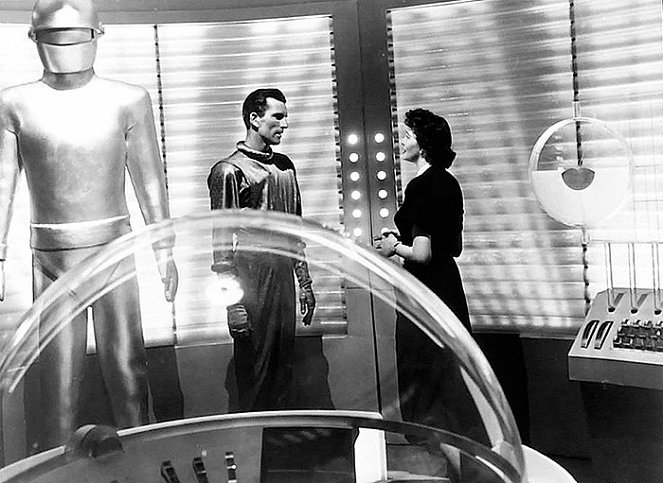
Giant monsters and other gems from the 1950s
Legendary special effects artist and animator Ray Harryhausen, who would later become famous for his work on fantasy films, worked on several sci-fi films of the 1950s. His first big hit was the science fiction horror film The Beast from 20,000 Fathoms (1953), followed by the thematically similar It Came from Beneath the Sea (1955), and shortly afterwards by the stylistically different Earth vs. the Flying Saucers (1956). In 1957, Harryhausen worked on 20 Million Miles to Earth, in which a group of astronauts returning from an expedition from Venus land in the sea carrying the egg of an alien organism that gradually grows to an unimaginable size, and in the 1960s he provided his models and characteristic effects for the British science fiction films Mysterious Island (1961), based on a story by Jules Verne, and First Men in the Moon (1964), based on a story by H.G. Wells.
However, a large number of science fiction films in the 1950s were cheap B-movies that would be forgotten years later in favour of stronger and more serious competition. One exception was The Thing (1951), about a team of scientists who discover a spaceship frozen in the Antarctic ice with an alien occupant, which, after thawing, begins to kill the crew of the polar base one by one. Also notable were the famous adaptations of Jules Verne’s 20,000 Leagues Under the Sea (1954) and Journey to the Center of the Earth (1959), and Stanley Kramer's existential post-apocalyptic film On the Beach (1959), in which Australians, the last survivors of a nuclear war, come to terms with the looming radioactive fallout and the last months of their lives.
Thanks to their extraordinary and ridiculous ineptitude, curiosities such as Robot Monster (1953), in which the title monster was portrayed by a man in a gorilla costume and a spacesuit helmet, and Ed Wood's Plan 9 from Outer Space (1959), in which flying saucers suspended from fishing lines were one of the more sensible creative solutions of this infamous filmmaker, would achieve cult status decades later. Some horror films about humanity's struggles against giant mutated monsters or overgrown animals, such as Behemoth the Sea Monster (1959), Them! (1954), Tarantula (1955), and The Black Scorpion (1957), are also included in the sci-fi genre. This category also includes Japan's Godzilla (1954), inspired by the trauma of World War II, and America's King Kong (1933), which reflected people's fear of radiation and nuclear weapons. The former was later followed by many other Japanese films with so-called kaiju monsters, such as Rodan, Gamera, Mothra and King Ghidorah.
Them! (1954)
Photo © Warner Bros.
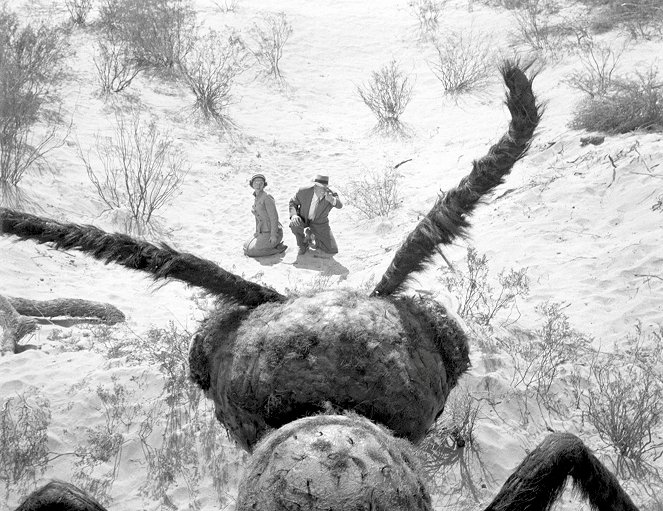
2001: A Space Odyssey and other genre milestones of 1968
The development of science fiction in the 1960s largely continued in the vein of the B-movie productions of the previous decade with films such as Master of the World (1961), a story inspired by several Jules Verne novels about the fanatical captain of a giant airship who tries to bring world peace by bombing cities and destroying all weapons of mass destruction, Robinson Crusoe on Mars (1964), a quirky adaptation of the adventure novel about the famous survivor, and Fantastic Voyage (1966), in which a group of scientists are reduced to the size of bacteria and embark on an adventurous journey into the bowels of the human body. A major contribution to genre, however, was Stanley Kubrick's 2001: A Space Odyssey (1968). Based on a short story by A.C. Clark, Kubrick's masterpiece became a revolutionary genre film that set a new bar for its realistic depiction of spaceflight, earned an enduring reputation as a timeless classic that managed to add a philosophical and even transcendental dimension to its science fiction story, and caused the entire genre to be taken much more seriously from then on.
Many older science fiction films struggled with the fact that their often naive visions of space colonisation and life on spacecrafts or other planets became significantly outdated as a result of the rapid growth of scientific knowledge in this field, helped greatly by the development of the US and Soviet space programmes. By contrast, the production design of 2001: A Space Odyssey remains believable even to this day – the realistic, groundbreaking and detail-oriented special effects were created in accordance with the scientific knowledge and projects of the time, such as the construction of space shuttles, the launching of satellites into orbit, and even man's stay in space. The unprecedented audiovisual form of the film also underscored its story, which deals with the evolution of mankind from prehistoric times to the distant future. In 1969, a year after the film's premiere, the rivalry between the US and the Soviets for the conquest of space culminated in NASA's first success in putting a man on the moon.
But 1968 saw the release of another film that would have a profound impact on the science fiction genre and many future filmmakers: Planet of the Apes, directed by Franklin J. Schaffner and based on a French novel about a group of astronauts who land on a distant planet inhabited by intelligent apes. The film was a success thanks to its portrayal of a post-apocalyptic world with the help of advanced make-up effects, also enriched an original story with a striking twist, which consisted of a critique of war by pointing out their far-reaching consequences. From a completely opposite end of the sci-fi spectrum, the extravagant Barbarella, based on the visually original comic book of the same name and heavily influenced by the ongoing sexual revolution, became a cult film thanks to its peculiar concept.
2001: A Space Odyssey (1968)
Photo © 1968 Metro-Goldwyn-Mayer (MGM)
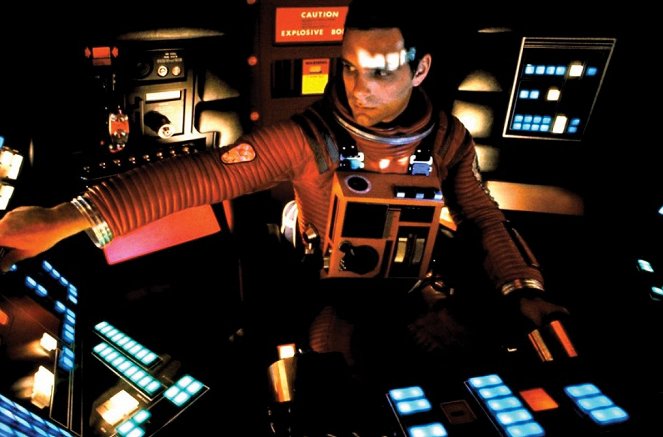
British and Soviet science fiction films of the 1960s and 70s
In contrast to the US, where few (but very important) science fiction films were made in the 1960s, the genre saw a significant surge in the UK. British science fiction films largely resembled American ones – indeed, many American representatives of this genre had already been co-produced with the UK. Purely British, for example, was the dystopian 1984 (1956), an adaptation of George Orwell's novel, which dealt with a vision of a totalitarian world in which any hint of individualism is punished. Fahrenheit 451 (1966), based on a novel by Ray Bradbury, presented a different form of totalitarianism in which human thought was influenced by an absolute ban on books. An example of British disaster science fiction was The Day the Earth Caught Fire (1961), in which the Earth moved closer to the Sun due to a misaligned axis, while in the paranoid sci-fi film Unearthly Stranger (1963), someone tries to eliminate space scientists. Also notable was the film series that began with The Quatermass Xperiment (1955) and culminated in Quatermass and the Pit (1967), which was based on a British series from the 1950s that combined science fiction and horror. Of particular note from the 1970s was The Man Who Fell to Earth (1976), about a human-looking alien stranded on Earth who tries to get back to his home planet.
The Soviet Union was quite prolific in science fiction cinema because it had to create a counterpoint to American productions in which the Americans were credited with the conquest of space. In Planet of Storms (1962), for example, it is a group of Soviet cosmonauts who become the first visitors to Venus, discovering a prehistoric world with dinosaurs, while Pilot Pirx's Inquest (1978), co-produced with Poland, was about a risky flight to Saturn, and Moscow: Cassiopea (1973), Teens in the Universe (1974) and The Big Space Travel (1975) told the adventures of spaceships inhabited by a crew of children. The Amphibian Man (1962) told the story of a boy whose life is saved by a shark gill transplant, and in The Aquanauts (1979) the main character, a diver, was confronted with a stingray that swallowed a memory chip from his deceased girlfriend. Completely unique and full of symbolism were the philosophical and mystical sci-fi films Solaris (1972) and Stalker (1979) by director Andrei Tarkovsky, which are ranked among the greatest artistic gems of world cinema.
Stalker (1979)
Photo © Mosfilm
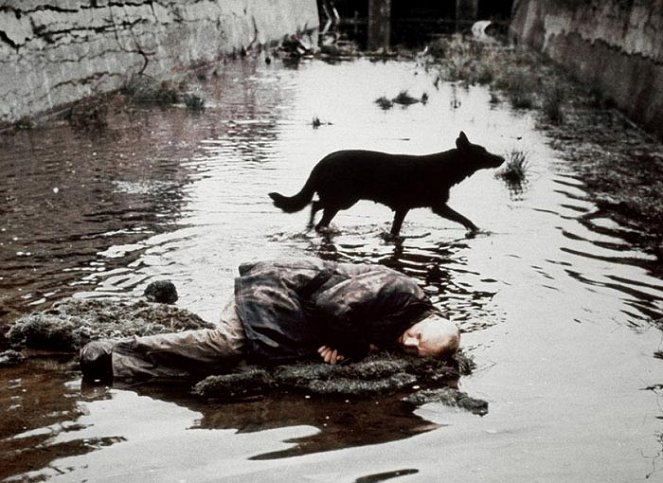
Other European science fiction productions from the 1950s to the 80s
Science fiction films made in Eastern Europe were not so influenced by American genre models and thus retained their own distinctive character, not only in terms of themes but also in terms of execution. Many of the plots were based on literary classics, for example, First Spaceship on Venus (1959), a film about the search for civilisation on that planet, co-produced by Poland and East Germany, was an adaptation of a book by Stanisław Lem, whose work was also the basis for the Czechoslovak science fiction film Icarus XB 1 (1963), which was visually up to the standards of Hollywood science fiction and attracted considerable international acclaim when it was released. Some films by the Czechoslovak director Karel Zeman, such as The Deadly Invention (1958) and On the Comet (1970), were made as homages to the novels of Jules Verne. Czechoslovakia also produced several science fiction comedies, including, among others, I Killed Einstein, Gentlemen (1969), in which a time machine is used to travel into the past in order to kill Albert Einstein and avoid the prospect of a world full of bearded women, and Tomorrow I'll Wake Up and Scald Myself with Tea (1977), in which playing with time serves to change the minds of a group of Nazis trying to deliver a hydrogen bomb to Adolf Hitler.
In France, director and screenwriter Jean-Luc Godard made Alphaville (1965), an experimental science fiction film about a world controlled by an artificial intelligence that has banned all emotions. The sci-fi element in the form of visitors from other planets featured in the French comedies The Troops & Aliens (1979) and The Cabbage Soup (1981), while in Poland, the sci-fi motifs manifested themselves in the comedy Sexmission (1983), in which two male protagonists frozen as part of a scientific experiment awake to a world in which women are the dominant species and men have become extinct. In Italy, the science fiction genre was taken up by horror filmmaker Mario Bava with Planet of the Vampires (1965), about the crew of a spaceship that descends into a state of incomprehensible aggression while trying to find the source of an emergency signal on an unknown planet. Co-produced by East Germany, Bulgaria and the Soviet Union, the existential sci-fi drama Eolomea (1972) tells the story of two former astronauts who dream of returning to Earth on an asteroid.
Planet of the Vampires (1965)
Photo © American International Pictures (AIP)
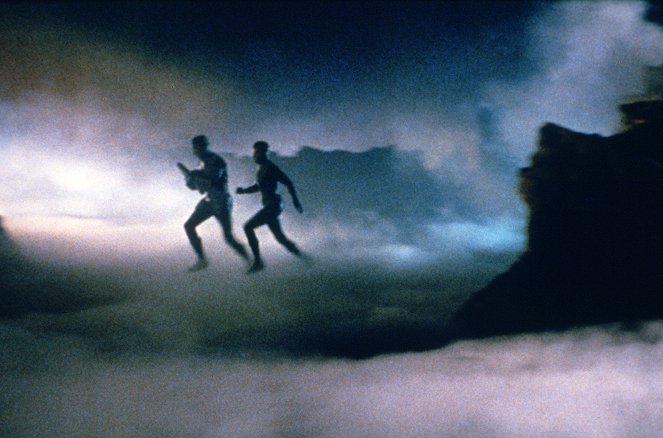
Star Wars and the rise of dystopias
The 1970s saw the rise of dystopian and anti-utopian science fiction, dealing with various forms of totalitarianism and paranoia in society. Typical examples are George Lucas's THX 1138 (1971), whose uniformed heroes rebel against the system, Silent Running (1972), set on a giant spaceship that cultivated trees that could no longer take hold on Earth, Soylent Green (1973), in which humanity struggles with food shortages, Westworld (1973), set in a Western theme park full of robots, and Logan's Run (1976), in which the world is run by an artificial intelligence that does not allow people to live past the age of thirty. Other science fiction films include The Andromeda Strain (1971), about scientists dealing with a deadly space microorganism, and Phase IV (1974), in which scientists take things too far in their research of intelligent ants. In contrast, the science fiction films Sleeper by Woody Allen (1973) and Dark Star by John Carpenter (1974) strayed into the comedy genre.
In 1977, director and screenwriter George Lucas made Star Wars (later renamed Star Wars: Episode IV - A New Hope), an important film that would forever change the face of pop culture. Set in a galaxy far, far away with a unique mythology, it give rise to a massively popular cult film franchise combining science fiction and fantasy. This epic film packed with special effects became a huge phenomenon, whose incredible success gave rise to a vast franchise that includes not only a number of films, but also TV series, comics, novels, video games, board games, toys, collectible figures and other products.
But the late 1970s saw several more hits on the silver screen. Steven Spielberg's Close Encounters of the Third Kind (1977) was extremely successful, starring an ordinary electrician, and featuring for the first time in many years the visit of aliens that did not pose a threat. It received eight Oscar nominations, while Lucas's Star Wars received ten in the same year. 1979 saw the release of Star Trek: The Motion Picture, the follow-up to the successful television series, which became the first instalment of a soon-to-be-popular film saga. Ridley Scott's pioneering Alien (1979) was also a considerable success, giving birth not only to an iconic movie monster, but also to a new wave of sci-fi horror, which was later followed by John Carpenter's The Thing (1982), a remake of the film of the same name from the early 1950s.
La Guerre des étoiles (1977)
Photo © 1977/1997 20th Century Fox
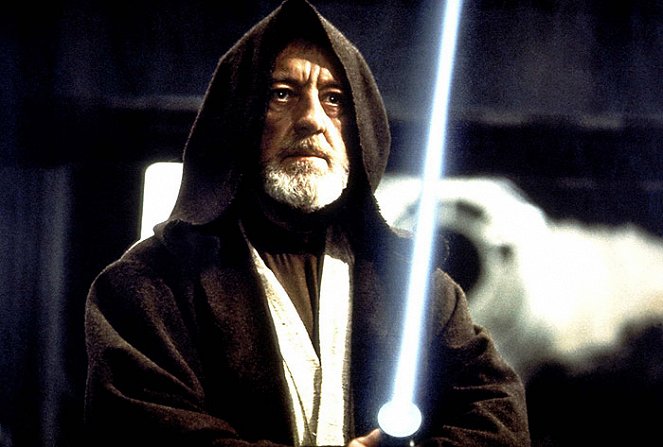
E.T.: The Extra-Terrestrial, The Terminator and other gems of the first half of the 1980s
The incredible popularity of Star Wars led to the production of two sequels subtitled The Empire Strikes Back (1980) and Return of the Jedi (1983), but they were not directed by George Lucas. Meanwhile, the financial success of Close Encounters of the Third Kind allowed Steven Spielberg to make E.T.: The Extra-Terrestrial (1982), one of the highest-grossing films of the entire decade, in which a defenceless visitor from outer space is taken in by a group of children. The popular TV hero of the science fiction series Flash Gordon came to life on the silver screen in the 1980 film of the same name; the hypnotically dark Blade Runner (1982), directed by Ridley Scott and based on a novel by Philip K. Dick, told of a world where people lived alongside replicant-artificial humans, and filmmaker David Lynch raised the funds for Dune (1984), an adaptation of Frank Herbert's novel about power wars between the rulers of different planets in the far future. Walt Disney Studios produced first the science fiction film TRON (1982), which experimented with computer animation by taking its main character into the world of computer games, and then several science fiction films for children, such as Flight of the Navigator (1986) and Honey, I Shrunk the Kids (1989).
Dystopian and post-apocalyptic visions of the future featured, for example, in Escape from New York by John Carpenter (1981), set in a prison colony in Manhattan, The Running Man (1987), in which convicts can achieve freedom by participating in a brutal reality TV show, and the Australian Mad Max (1979) and its sequels Mad Max 2: The Road Warrior (1981) and Mad Max Beyond Thunderdome (1985), depicting the fate of a former police officer fighting motorcycle gangs. Star Trek: The Motion Picture saw four sequels in the 1980s alone, the most famous of which was Star Trek II: The Wrath of Khan (1982). Sci-fi elements also played a significant role in some of Canadian director David Cronenberg's horror films, such as Scanners (1981), Videodrome (1983) and The Fly (1986), while director and screenwriter James Cameron succeeded with the dark sci-fi film The Terminator (1984), about a humanoid killer robot sent into the past to kill the mother of a future resistance leader in the coming war against the machines, beginning a famous film franchise that has become one of the cornerstones of the genre.
Blade Runner (1982)
Photo © Warner Bros.
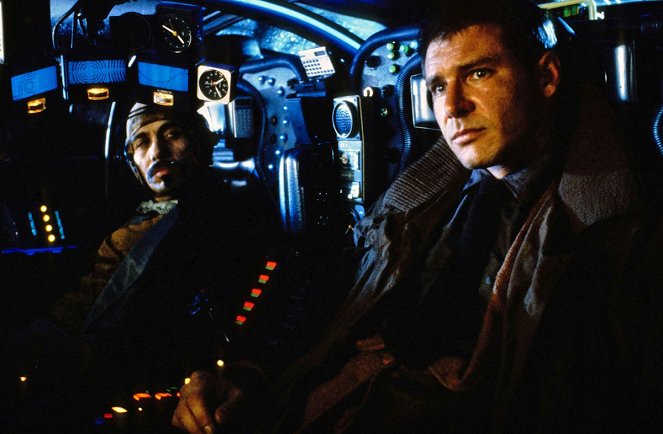
Aliens, Predator and the second half of the 1980s
In the wake of the excellent response to The Terminator, James Cameron followed up the critically acclaimed Alien with a much more action-packed sequel, Aliens (1986), which turned in two of its seven Oscar nominations. It was followed by Predator (1987), directed by John McTiernan, which introduced what would become another legendary alien monster. Director Paul Verhoeven, for his part, succeeded with RoboCop (1987), a gritty tale of a cybernetic policeman who uncompromisingly brings order to a world dominated by corporations and crime. Robert Zemeckis also enjoyed success with the comedic sci-fi trilogy Back to the Future (1985, 1989 and 1990), whose protagonists repeatedly travel between the past, present and future in an attempt to correct their own mistakes, leading to existential paradoxes.
James Cameron continued to make science fiction in the late 1980s with The Abyss (1989), which dazzled with its advanced digital effects, and John Carpenter followed up with Starman (1984), a romantic film about a widowed woman and an alien who takes the form of her late husband, and carried on his sci-fi work with They Live (1988), about a man on the trail of an alien conspiracy to enslave humanity. Also notable were Wolfgang Petersen's Enemy Mine (1985), in which mankind has ended all Earth wars only to start a war with an alien race, Mel Brooks's parody of sci-fi films Spaceballs (1987), and Joe Dante's comedy Innerspace (1987), about the crew of a microscopically shrunken submarine that is injected with a syringe into the body of an unsuspecting human.
In the UK there was a new of adaptation of Orwell’s novel “1984” (made symbolically that same year), which to some extent inspired Terry Gilliam's cult dystopian film Brazil (1985), telling the story of life in a totalitarian society riddled with bureaucracy from the perspective of a timid civil servant. Also worth mention are some representatives of then-emerging Japanese science fiction, especially the epic existential anime Akira (1988) and the cyberpunk experimental Tetsuo: The Iron Man (1989), whose protagonist transforms into a metal monster.
Aliens (1986)
Photo © 1986 20th Century Fox
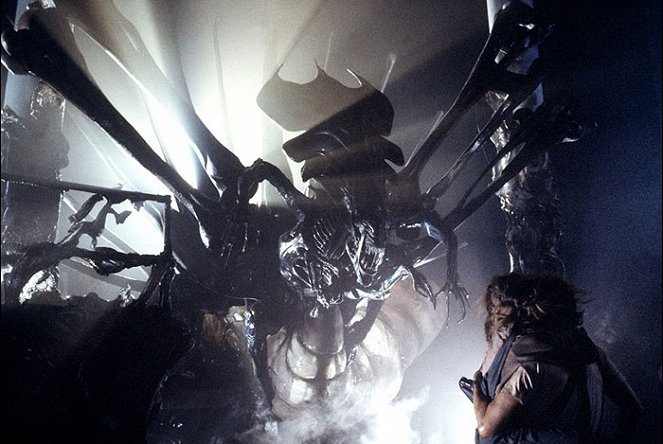
The advent of digital technologies
Telling the story of the line between fact and fiction, Paul Verhoeven's science fiction film Total Recall (1990) featured a protagonist confronted with his past as a secret agent during a vacation on Mars, and was one of the last big-budget Hollywood films to favour practical effects over CGI. A year later, James Cameron revolutionized digital effects with Terminator 2: Judgment Day (1991), pitting the Terminator from the previous film against a seemingly indestructible foe made of liquid metal, symbolizing the danger of new technologies and the fear of an underexplored digital world. At the time, it was the highest grossing film ever, received Academy Awards nominations, and remains one of the best action and science fiction films in cinema history. Steven Spielberg's Jurassic Park (1993), was also revolutionary with a plot revolving around the creation of a nature reserve with cloned dinosaurs. It believably combined computer effects with animatronics, became the highest-grossing film in history and had two sequels: The Lost World: Jurassic Park (1997) and Jurassic Park III (2001).
The development of computer graphics led to a renaissance in disaster science fiction films, such as Deep Impact (1998), in which the Earth is threatened by an approaching comet, Armageddon (1998), in which the threat this time is an asteroid, and Independence Day (1996), in which humanity must deal with devastating attacks by alien ships. Independence Day was directed by Roland Emmerich, who, after Universal Soldier (1992), broke onto the sci-fi scene with Stargate (1994), based on the TV series of the same name, and later made the American version of Godzilla (1998). Digital effects were also used in the sci-fi horror films Species (1995), Cube (1997) and The Faculty (1998), as well as in Paul Verhoeven’s satirical Starship Troopers (1997), which took on war propaganda in a story about humanity's battles with alien bugs.
Jurassic Park (1993)
Photo © Universal Pictures
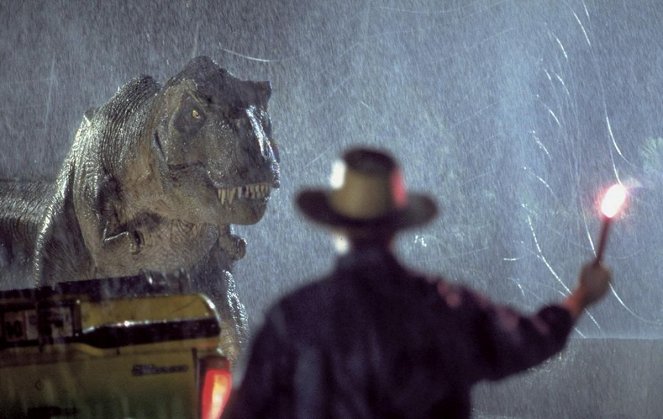
Other prominent science fiction films of the 1990s
Demolition Man (1993), Judge Dredd (1995) and Carpenter's sequel to Escape from New York, Escape from L.A. (1996), all had plots that combined action and sci-fi. With regards to sequels, the 1990s also saw Predator 2 (1990), Alien³ (1992) and Alien: Resurrection (1997), RoboCop 2 and RoboCop 3 (1990 and 1993), and four sequels to Star Trek in 1991, 1994, 1996 and 1998. In contrast, films such as Waterworld (1995) and The Postman (1997) depicted life in a world affected by the aftermath of an apocalypse, while Memoirs of an Invisible Man (1992) and Body Snatchers (1993) tried to revive classic sci-fi themes.
There were also a number of already famous directors who continued making science fiction. Terry Gilliam directed 12 Monkeys (1995), which travelled into the past to prevent a viral contagion responsible for the extinction of most of humanity; Robert Zemeckis made Contact (1997), in which the heroine embarks on a journey to another galaxy in search of the source of a mysterious signal; and David Cronenberg directed eXistenZ (1999), a film about the virtual worlds of computer games, in which he imaginatively combined modern technology with organic tissue. Event Horizon (1997), whose heroes embarked on a rescue mission to the edge of the solar system, had a horror atmosphere, the anti-utopian Gattaca (1997) dealt with the issue of genetic engineering, and The Fifth Element (1997) offered a colourful variety of the future on Earth and alien worlds. The X-Files (1998), about a pair of investigators searching for the causes of mysterious phenomena, was based on the TV series of the same name, while the Japanese anime Ghost in the Shell (1995) became significant in terms of its influence on the sci-fi genre. In contrast, the comedies Mars Attacks! (1996), Men in Black (1997) and Galaxy Quest (1999) offered some relief in the genre.
The Fifth Element (1997)
Photo © 1997 Columbia Pictures
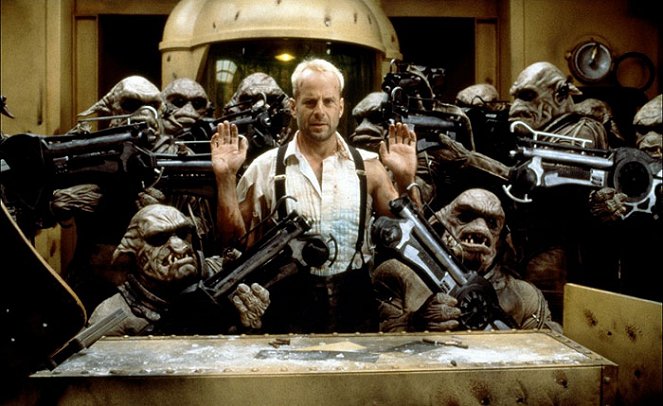
The Matrix and the beginning of the new millennium
The cinematic highlight of the turn of the millennium was the cult classic The Matrix (1999). It was set in a world controlled by machines and artificial intelligence that had taken over humanity, which they maintained only as an energy source – unsuspecting humans were connected to virtual reality, unaware that they were not living real lives. This spectacularly conceived film won over the crowds, became a widely cited pop culture phenomenon and famous for its conception of reality as a computer program that anyone could plug into and unplug from. It also became famous for its multiple interpretations, choreographed action sequences and its references to everything from comic books and Japanese anime to religious symbolism and cyberpunk elements. Its success was followed by two sequels: The Matrix Reloaded (2003) and The Matrix Revolutions (2003) and also the thematically related animated The Animatrix (2003).
The first instalment of George Lucas's Star Wars prequel trilogy, Star Wars: Episode I - The Phantom Menace (1999), premiered the same year as The Matrix and would go on to gross over a billion dollars. It was followed by the second and third episodes, subtitled Attack of the Clones (2002) and Revenge of the Sith (2005), which were also very successful, but did not reach the earnings of The Phantom Menace. Pitch Black (2000) and its sequel The Chronicles of Riddick (2004), featuring a protagonist with the ability to see in the dark, also gained many fans. Another popular franchise is the horror sci-fi Resident Evil (since 2002), based on popular computer games. Steven Spielberg, for his part, made the films A.I. Artificial Intelligence (2001), about a robot boy adopted by a human couple, and Minority Report (2002), in which crimes are punished before they happened. M. Night Shyamalan wrote and directed Signs (2002), whose characters had to deal with crop circles and aliens, Alex Proyas was inspired by a collection of short stories by Isaac Asimov in I, Robot (2004), which described the three ethical laws of robotics, and The Hitchhiker's Guide to the Galaxy (2005) brought to life Douglas Adams’s book of the same name.
Other representatives of science fiction produced at the turn of the millennium include Sky Captain and the World of Tomorrow (2004), the first film shot with a completely digital background, set in an alternate past full of airships and giant robots, Deja Vu (2006), a thriller about the investigation of a terrorist attack using technology that depicted a three-day-old past, Transformers (2007 onwards), a film franchise inspired by children's robotic toys and a television series, Sunshine (2007), a visually captivating film depicting the fate of a spaceship crew on a suicide mission to reignite the dying sun, the seemingly authentic Cloverfield (2008), and the animated WALL-E (2008), about the love of two robots in the backdrop of a desolate and depopulated Earth. Dystopian visions of the future were also explored in Equilibrium (2002), V for Vendetta (2005) and Children of Men (2006). There was also a third instalment of The Terminator called Terminator 3: Rise of the Machines (2003), while Alien vs. Predator (2004) attempted to pit the two famous space monsters against each other. Tim Burton's Planet of the Apes (2001), Steven Soderbergh's Solaris (2002), Spielberg's War of the Worlds (2005) and Scott Derrickson's The Day the Earth Stood Still (2008) were remakes of older famous science fiction films.
The Matrix (1999)
Photo © 1999 Warner Bros.
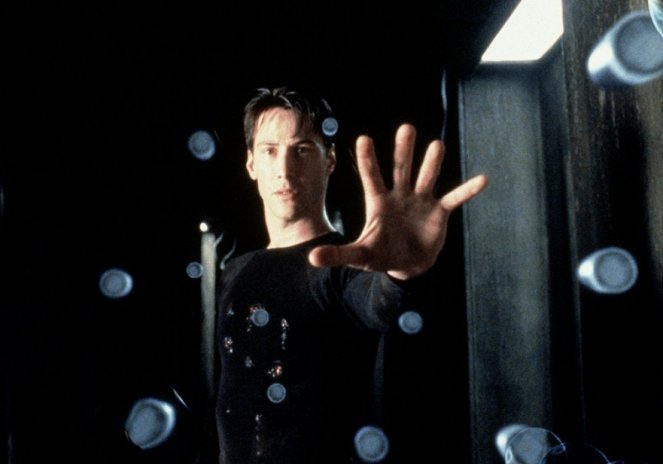
The boom of the superhero genre
Superhero films are defined by the protagonists possessing (usually supernatural) powers that they use to save the world from various villains and to protect the public from criminals, disasters and danger in general. Most of them are based on comics first published in the 1930s, many of which fell into the science fiction genre, but some were related to fantasy, especially those that had a complex fictional mythology, such as Spawn (1997), Thor (2011) and Wonder Woman (2017). A forerunner of this genre was, for example, the adventure film The Mark of Zorro (1920), whose masked hero fought injustice without any superpowers. In the 1940s, comic book superheroes regularly appeared on television screens as the protagonists of serials and continued to operate in this form until the end of the 1960s. There were isolated feature films featuring them following the TV series, such as the hilariously wacky Batman: The Movie (1966), about a millionaire defending justice in a bat costume.
The first big-budget superhero film was Superman (1978), starring a man from another planet sent to Earth as a child, who wielded supernatural powers and other abilities. Batman received a more serious treatment as the namesake 1989 film, which, like Superman, was followed by several sequels. The 1990s saw the release of The Rocketeer (1991), a family film set in the 1930s about a pilot who invented a harness that allows humans to fly. In contrast, X-Men (2000), about a group of mutants coping with the pressures of the outside world and themselves, surprised with its realistically mature approach and opened the door to a vast, multi-part film franchise. In the 2002 film Spider-Man, the superhero was a student who gained superhuman powers after being bitten by a genetically modified spider, and its success led to a trilogy (2004 and 2007). The Incredibles (2004), on the other hand, was an animated film about a family of superheroes. The superhero films Hulk (2003), Fantastic Four (2005) and Watchmen (2009), set in an alternate America that won the Vietnam War, also fell into the sci-fi genre.
Superman Returns (2006) was a great homage to the Superman films of the 1970s, and its counterpart was the trilogy that started with Batman Begins (2005), whose sequel The Dark Knight (2008) turned in two of its eight Oscar nominations. After Iron Man (2008), Disney bought out Marvel and successfully took on its superheroes to create a single, connected universe. This led to Warner Bros. wanting to pursue the same with the superheroes of DC, starting with Man of Steel (2013). Disney capped off their efforts with the hugely successful large-scale film franchise The Avengers (since 2012), in which Iron Man was joined by, among others, the characters from Captain America: The First Avenger (since 2011), Ant-Man (since 2015), Guardians of the Galaxy (since 2014), Spider-Man: Homecoming (2017) and Black Panther (2018), the first comic book film in history to be nominated for an Academy Award in the Best Picture category. Meanwhile, the culmination of Warner Bros. efforts was Justice League (2017). Deadpool (2016) became the highest-grossing R-rated film of all time, and the conclusion of The Avengers saga, Avengers: Endgame (2019), even went on to top the list of highest-grossing films ever. In terms of science fiction, other films worth mention are Logan (2018), the first superhero film to be nominated for an Academy Award for screenplay, and the animated Spider-Man: Into the Spider-Verse (2018), which set the popular superhero in a visually appealing way in an environment of intersecting alternate dimensions.
Spider-Man (2002)
Photo © 2002 Columbia Pictures
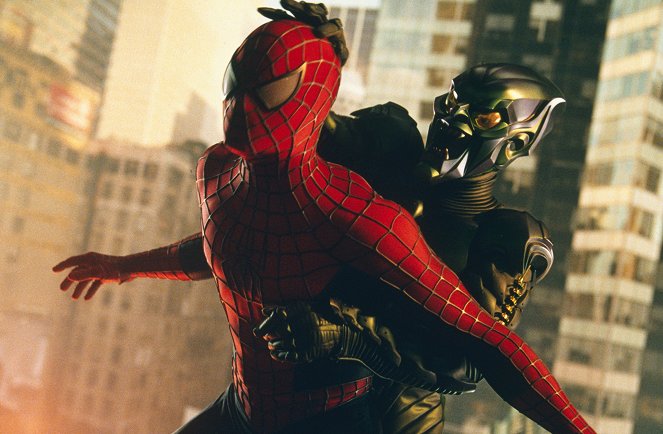
Avatar, sci-fi reboots and Oscar-winning sci-fi films
James Cameron's groundbreaking Avatar (2009) was a massive success that deepened audiences' interest in 3D movies and became the highest-grossing film in cinema history until it was overtaken by Avengers: Endgame in 2019. The film, about a clash between humans and the native aliens of the moon Pandora, was nominated for nine Academy Awards, including Best Picture. His competitor in the same category was Neil Blomkamp's District 9 (2009), set in an alternate present in which humanity has taken in alien refugees, settling them in a territory in South Africa. Several other science fiction films received the same nomination: Christopher Nolan’s Inception (2010), whose heroes made a living infiltrating other people’s dreams, Alfonso Cuarón's visually intoxicating Gravity (2013), which turned in seven of its ten Oscar nominations, Spike Jonze's intimate drama Her (2013), whose protagonist falls in love with an artificial intelligence in an advanced operating system, Ridley Scott's The Martian (2015), about an astronaut left stranded on Mars, Denis Villeneuve's Arrival (2017), whose story revolved around trying to understand a unique alien language, and the aforementioned superhero film Black Panther (2018).
A significant number of films during this period returned to established sci-fi brands with numerous sequels and remakes of older classics. Alien was revived in Prometheus (2012) and Alien: Covenant (2017), the Predators were revisited in Predators (2010) and The Predator (2018), and the terminator universe was further developed with Terminator Salvation (2009), Terminator Genisys (2015) and Terminator: Dark Fate (2019). The Star Wars saga was expanded with a trio of follow-up films: The Force Awakens (2015), The Last Jedi (2017) and The Rise of Skywalker (2019), and the standalone titles Rogue One: A Star Wars Story (2016) and Solo: A Star Wars Story (2018). The Star Trek film franchise also received a reboot (since 2009), the apes reemerged in the trilogy Rise of the Planet of the Apes (2011), Dawn of the Planet of the Apes (2014) and War for the Planet of the Apes (2017), and the remake fad also produced Total Recall (2012), a new Godzilla (2014) and a live-action adaptation of Ghost in the Shell (2017), among others. Other sequels arrived in the form of TRON: Legacy (2010), Mad Max: Fury Road (2015) and Blade Runner 2049 (2017).
Avatar (2009)
Photo © Twentieth Century-Fox Film Corporation

Young Adult Sci-fi and other genre representatives
There was no shortage of original themes, either. For example, Duncan Jones's Moon (2009) told the story of a maintenance worker on the moon who discovers he is not alone, Neil Blomkamp's Elysium (2013) saw the wealthiest class move to a space station, the protagonist of Nolan's Interstellar (2014) abandons his children in search of a suitable planet to move humanity off Earth, and in Morten Tyldum's Passengers (2016), two passengers on an interstellar flight are forced to spend the rest of their lives in an empty spaceship due to an early awakening from hibernation. Told in six different time periods and across genres, Cloud Atlas (2012) explored the theme of reincarnation, Tomorrowland (2015) offered a rare glimpse of a purely utopian future, and Valerian and the City of a Thousand Planets (2017) captivated with its imaginative visual design of life on alien planets.
Source Code (2011) and Edge of Tomorrow (2014) used the time loop motif, Ex Machina (2014) and Alita: Battle Angel (2019) featured robotic women, and Looper (2012) and Predestination (2014) dealt with time travel. Battleship (2012) was based on a popular board game, Pacific Rim (2013) was influenced by Japanese kaiju monsters and giant robots, and Spielberg's Ready Player One (2018) was inspired by video games.
There have also been several film franchises based on dystopian science fiction novels for young adults, whose protagonists are teenagers who, in addition to battling government systems, also experience romantic relationships. Typical representatives of this specific sub-genre are, for example, the trilogy The Maze Runner (2014), Maze Runner: The Scorch Trials (2015) and Maze Runner: The Death Cure (2018), the series started with Divergent (2014), and The Hunger Games saga (since 2012).
Interstellar (2014)
Photo © Warner Bros. Pictures
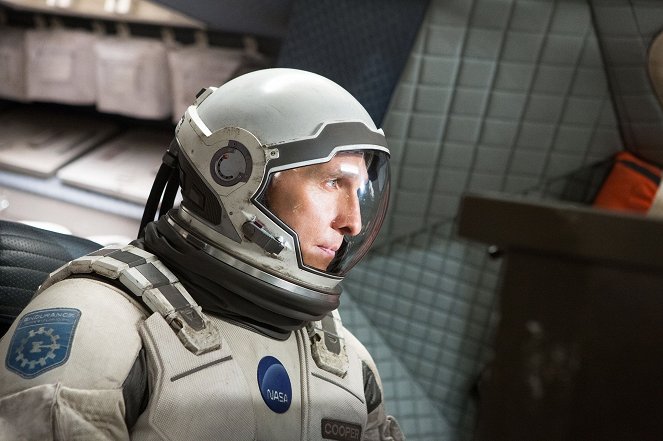
Science fiction on television
Science fiction has been part of the world of television since the 1940s, when the medium was becoming an affordable and increasingly popular technology. The science fiction series Captain Video and His Video Rangers, broadcast from 1949 to 1955, became revolutionary at the time, moving television entertainment into fictional space worlds for the first time. Other notable science fiction series were Flash Gordon (from 1954), The Twilight Zone (from 1959), The Outer Limits (from 1963), Lost in Space (from 1965), the animated children's series The Jetsons (from 1962) and the British series Doctor Who (from 1963), which stayed on the screen for several decades, became globally popular and influenced much of the upcoming television output. Star Trek (since 1966) was similarly exceptional, giving rise to a cult franchise with an extremely large fan base, while the British comedy Red Dwarf (since 1988) and the American mystery series The X-Files (since 1993) have remained popular to this day. Other series that were well received in the 1990s include Babylon 5 (since 1994), The Outer Limits (since 1995) and Stargate SG-1 (since 1997).
The post-2000 boom in digital technology and science fiction filmmaking has also been reflected in TV productions, leading to very popular series such as Firefly (since 2002), Battlestar Galactica (since 2004), Heroes (since 2006), Fringe (since 2008), Misfits (since 2009) and the new version of Doctor Who (since 2005). After 2010, the number of sci-fi series increased even more, and some of the most popular include Black Mirror (since 2011), Rick and Morty (since 2013), The Flash (since 2014), The Expanse (since 2015), Westworld (since 2016), Stranger Things (since 2016), Legion (since 2017), Lost in Space (since 2018), Altered Carbon (since 2018), Watchmen (since 2019), and Snowpiercer (since 2020), while Marvel's Agents of S.H.I.E.L.D. (since 2013) and Agent Carter (since 2015) emerged from the world of superheroes, and The Mandalorian (since 2019) drew from the Star Wars mythology.
Filmmaniak
Best sci-fi films
Terminator 2: Judgment Day (1991) |
The Matrix (1999) |
Alien (1979) |
Aliens (1986) |
Star Wars: Episode V - The Empire Strikes Back (1980) |
Back to the Future (1985) |
Inception (2010) |
Le Prestige (2006) |
La Guerre des étoiles (1977) |
Dune: Part Two (2024) |
| All the best sci-fi films |


